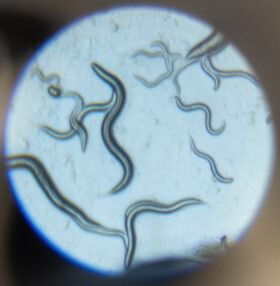
As a biology major, we are provided with so many external and internal opportunities. At BSU, the world is yours and they give you every opportunity to do what you want to do.
The focus of Deborah Ashiedu’s undergraduate research is so small that she cannot see it with her own eyes. But Deborah hopes her work contributes to greater understanding of a big issue: human aging.
Inspired by her grandfather’s battle with Alzheimer’s disease, Deborah is studying tiny worms called C. elegans with the goal of gaining new insights into the aging process.
“When I came in as a freshman, I didn’t know what research was,” said the senior biology major from Brockton, who plans to pursue a master’s degree at BSU before attending physician-assistant school. “Now I’ve been able to present (my research) in front of people. ... It’s just so nice to put your work out there and convey to other people what you’ve done.”
C. elegans are ideal for research because they live for just a few weeks, allowing students to study their entire lifespan within a typical semester. While they look nothing like humans, the worms share enough similarities that this research can set the foundation for other scientists to study the same processes in mice and, eventually, humans.
“Using our model, we investigate the basic biology of what happens in the cells that would cause them to age,” said Dr. Joslyn Mills, an assistant professor of biological sciences who mentors six undergraduates and one graduate student in the research.
Students are completing a variety of projects with C. elegans, including studying different genes. Some projects focus on better understanding Huntington’s disease, a progressive, inherited neurodegenerative disorder.
BSU’s Undergraduate Research Program helps fund supplies as well as travel to the International Worm Meeting, which will bring C. elegans researchers together in California this summer.
Mills, who came to BSU from Wheaton College, focuses on this area of biology because it is a good way to introduce students to research.
“The experience of doing research is one of the most important things they can do at school,” she said. “It’s something they can apply to everyday life.”

Matthew Hull, ’25, first worked with Mills and C. elegans at Wheaton. He followed her to BSU (through an agreement between the two institutions) in order to continue his research.
“She has a very good way of teaching and conveying information, and the techniques are easy to follow,” said Matthew, who is from Monroe, Connecticut. “I was able to learn a lot along the way.”
Callie Millette, ’25, of Bridgewater, sees BSU research as good preparation for veterinarian school. She aims to become a neurologist, a career aspiration that solidified after she lost her cat to kidney disease.
“As a biology major, we are provided with so many external and internal opportunities,” Callie said. “At BSU, the world is yours and they give you every opportunity to do what you want to do.”
Do you have a BSU story you'd like to share? Email stories@bridgew.edu.